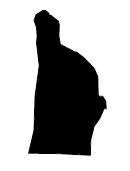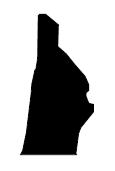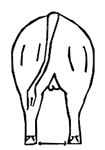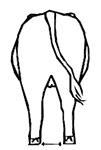Assessing muscle shape of cattle
If you want to produce cattle to meet buyer demand, you need to become skilled in assessing the muscle shape of your cattle, in order to recognise and produce the desired traits.
You can improve your technique for assessing muscle shape by becoming involved in field days on live animal assessment and carcase competitions where cattle are assessed prior to and after slaughter.
Before sale, you should also observe your cattle — making particular note, (in writing) — of four or five head. These cattle should then be followed through the abattoir, so you can compare the abattoir and their assessment. This is a valuable exercise to test your assessment skills, and receive direct feedback on the type of stock you are producing.
Muscle shape
The AUS-MEAT language defines the measure for muscle shape on the carcase as the fullness or roundness of the butt, which can be related to the live animal, and is scored on a scale of A (full muscling) to E (least muscling).
The muscle shape in the carcase is determined by the profile of the butt in relation to an imaginary straight line running from the butt of the tail to the outer area of the muscle attachment on the upper leg.
Assessing cattle for muscle shape
Prior to slaughter, an assessor will closely observe cattle to assist in the accurate assessment of the carcase muscularity. Muscle shape in cattle is highly predictable. If one muscle is well developed, other muscles on the animal will be of a similar shape.
While varying levels of fat on an animal influence its shape, so does the degree of muscle. The leaner the animal, the less the influence of fat on body shape, and the greater influence of muscle. During live animal assessment, the degree of muscling is considered separately from the degree of fatness.
Three main sites on the animal allow for muscle patterns to be studied without the influence of fat cover.
Rear view
The width through the stifle region and along the back running from the hips to the shoulders.
Viewed from the rear, a steer with a round, bulging muscle pattern will have a well-rounded loin region and rounded muscle development running forward toward the shoulder and showing maximum width through the stifle region.
A steer with a flat or angular muscle pattern will fall away along the borderline when viewed from the rear, showing little roundness over the loin region, and will have its widest rear view point much higher, up towards the tailhead. The hip bones and the stomach wall are more easily seen from the rear on a lightly muscled animal.
Upper foreleg
Between the shoulder and the knee. The upper foreleg can indicate the type of muscle of a beast because of the lack of fat development in that area.
Stance
Both width between the forelegs and width between the backlegs. A wide stance of the forelegs indicates round/bulging muscle separating each leg from the rib cage. A wide hindleg stance indicates a similar, bulging muscle pattern.
An animal with a round, bulging muscle pattern will show a pronounced movement of the muscles while in motion. For example — bulges can be seen to form over the rump and loin area while the animal is walking — which is far less pronounced on a less muscled animal.
Muscle scores
| A VERY HEAVY MUSCLING | B HEAVY MUSCLING | C MEDIUM MUSCLE | >D MODERATE MUSCLE | E LIGHT MUSCLE |
|---|---|---|---|---|
|
|
|
|
|
|
|
|
|
|
|
|
|
|
|
A - Very heavy muscling
B - Heavy muscling
C - Medium muscling
D - Moderate muscling
E - Light muscling
Muscle pattern
| Round/bulging | Moderate | Flat/angular |
|---|---|---|
|
|
|
Wide, well rounded topline, maximum width through stifle, has a wide stance and the stomach cannot be seen. | Not as wide and well rounded over hipline, hip bones can be seen, has a narrower stance and the stomach is clearly visible. | Narrower over topline, tapering through stifle, narrower stance, more prominent hip bones, and stomach is more clearly visible. |
Round or bulging:
- wide, well rounded topline, maximum width through stifle, has a wide stance and the stomach cannot be seen
- not as wide and well rounded over hipline, hip bones can be seen, has a narrower stance and the stomach is clearly visible.
Flat or angular:
- narrower over topline, tapering through stifle, narrower stance, more prominent hip bones, and stomach is more clearly visible.

















